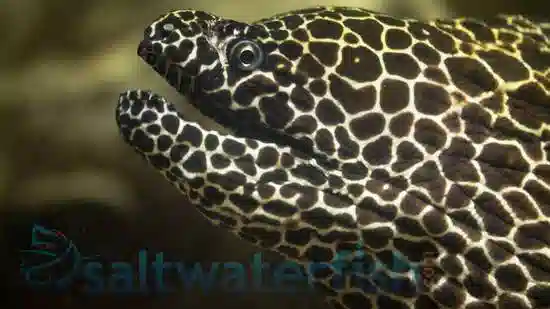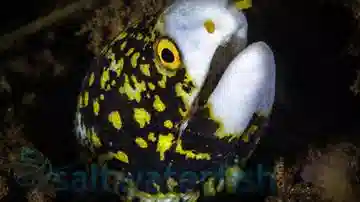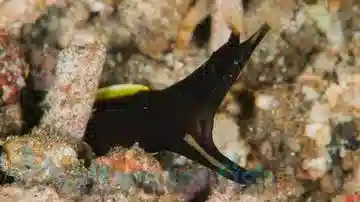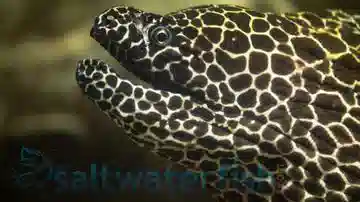Expert Only
Tesselata Eel
Gymnothorax favagineus
(1 Reviews)

Expert Only
Tesselata Eel
Gymnothorax favagineus
(1 Reviews)
{{ item.name }}
Size: {{ item.extra_field_3 }}
${{ getFormattedPrice(item.saleprice) }} ${{ getFormattedPrice(item.price) }}
To join the waiting list, click here
Free Shipping
With
$199.00
or more in Marine Life.
More details...
Tesselata Eel Care Facts
| Care Level: | Expert |
|---|---|
| Temperament: | Aggressive |
| Diet: | Carnivore |
| Reef Safe: | No |
| Minimum Tank Size: | 200 gallons |
| Max Size: | 70 inches |
Tesselata Eel (Gymnothorax favagineus) for Saltwater Marine Aquariums
In the world of saltwater marine aquariums, the Tesselata Eel (Gymnothorax favagineus) is a captivating and distinctive species that demands a comprehensive understanding. This analysis provides a fact-based exploration of the attributes, care requirements, and compelling reasons for choosing the Tesselata Eel from Saltwaterfish.com.
Habitat and Reef Compatibility of the Tesselata Eel
The Tesselata Eel is a native of the Indo-Pacific region, where it inhabits a range of environments, including coral reefs, rocky crevices, and sand beds. Regarding reef compatibility, caution is advised. Due to their predatory nature, Tesselata Eels may pose a threat to smaller fish and invertebrates, making them better suited to fish-only or FOWLR (Fish Only With Live Rock) setups.
Size and Lifespan of the Tesselata Eel
This eel species can grow significantly, reaching lengths of up to 70 inches (5-6 feet). Therefore, they require a spacious aquarium to accommodate their size. With proper care, Tesselata Eels can live for a remarkable 10 to 20 years in captivity.
Diet in Captivity
Tesselata Eels are carnivorous predators that primarily feed on fish and crustaceans in the wild. In captivity, they readily accept a diet of meaty foods, including fresh or frozen seafood such as squid, shrimp, and fish. It's essential to offer a varied diet to ensure their nutritional needs are met.
Aquaculture and Availability
Currently, Tesselata Eels are not aquacultured, making them reliant on responsibly sourced wild specimens. Saltwaterfish.com is committed to ethical collection practices, ensuring that the eels available to hobbyists are collected sustainably and acclimated for a smooth transition into aquarium life.
Compatibility with Other Fish and Invertebrates
Due to their predatory nature, Tesselata Eels are best housed with larger, robust fish that are less likely to become prey. Tank mates should be chosen carefully to avoid conflicts. Suitable tank mates include:
- Lionfish (Pterois spp.): These predatory fish are of similar size and disposition.
- Triggerfish (Balistidae family): Larger triggerfish can coexist with Tesselata Eels.
- Groupers (Serranidae family): Some larger species of groupers are compatible.
- Moray Eels (Muraenidae family): Tesselata Eels can share a tank with other moray eel species.
Temperament
Tesselata Eels are generally solitary and secretive in nature. They are known for their ambush hunting technique, relying on stealth and quick strikes to capture prey. Their temperament is characterized by caution and a preference for hiding.
Tank Requirements for the Tesselata Eel
To provide a suitable habitat for Tesselata Eels, consider the following tank requirements:
- Minimum Aquarium Size: A tank with a capacity of 200 gallons or more is recommended for adult specimens to accommodate their size and swimming needs.
- Substrate: Use a fine sandy substrate to mimic their natural habitat and prevent abrasions on their sensitive skin.
- Hiding Places: Incorporate rock structures and PVC pipes to create ample hiding spots.
- Lid or Cover: Ensure a secure lid or cover to prevent escapes, as these eels are known for their escape artist tendencies.
Detailed Water Conditions
- pH: 8.1 to 8.4
- Salinity: 1.023 to 1.025 specific gravity
- Water Temperature: 75°F to 82°F (23.9°C to 27.8°C)
- Water Flow: Provide moderate water flow to simulate their natural habitat.
Why Choose the Tesselata Eel from Saltwaterfish.com
Selecting the Tesselata Eel from Saltwaterfish.com ensures access to responsibly sourced and expertly shipped specimens. Saltwaterfish.com's commitment to sustainable collection practices guarantees that hobbyists receive healthy and well-adjusted eels. By choosing the Tesselata Eel from Saltwaterfish.com, enthusiasts support ethical marine trade and have the privilege of housing this captivating species in their personal marine aquariums.
Expert Only: Items designated as expert only require special care such as a species specific environment, special diet or care, and an expert level, experienced aquarist. Not for beginners. Expert Only items qualify for our live arrival guarantee only, and are exempt from our extended 8 day guarantee.
A gorgeous healthy Tesselata Eel. Arrived quickly and adapted quickly. Likes to hang out with my Mimic Tang. I purchased three different species and everyone is doing well!
Reviewed by: Mary Hallston on Sept. 12, 2021










